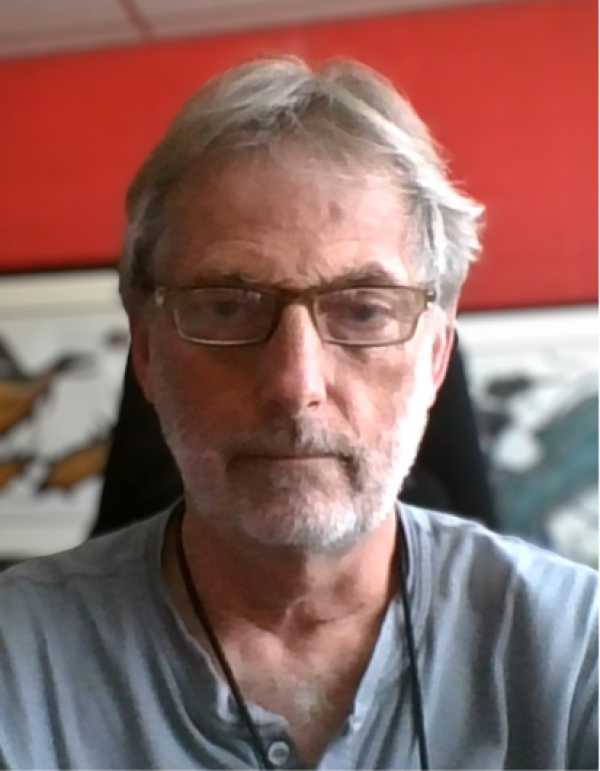Martin Ralph
Board Member from the Americas

- B. Sc. 1976 Biological Sciences, Stanford University
- Ph. D. 1986 Biology, University of Oregon
- Post-doc: Biology, University of Virginia, (1986-1989)
Martin Ralph was introduced to the field of biological clocks 45 years ago (1974) as an undergraduate working in the lab of Colin S. Pittendrigh. His project was on selective pressures restricting the timing of eclosion in D. melanogaster, but mainly he counted flies. Martin received a BSc in biological sciences from Stanford University in 1976. Following graduation, Martin took a hiatus from academia, and a job as project engineer/manager for an industrial engineering consulting company near Seattle, Washington, working on several multimillion-dollar projects in the United States and Canada.
Martin returned to science in 1982, and in 1986 received a Ph.D. in neuroscience from the University of Oregon under the supervision of Michael Menaker. Martin received a National Research Service post-doctoral fellowship from the NIH (US) in 1986 to work with Gene Block at the University of Virginia, working on the cellular basis of entrainment of the clock in the Bulla eye. Martin took up his first, and only, academic position at the University of Toronto in 1989, receiving a prestigious University Research Fellowship from the Natural Sciences and Engineering Council of Canada. Martin is currently a full professor with the University of Toronto Department of Psychology.
During his tenure in Toronto, Martin conceived the University’s Undergraduate Specialist Program in Neuroscience, and directed the Program from 2003 to 2007. Martin was President of the Southern Ontario Neuroscience Association 1992-1994. In 2003, he organized the Centre for Biological Timing and Cognition (CBTC), which received a $25 million award from the Canada Foundation for Innovation and the Ontario Ministry of Research and Innovation. Martin directed the CBTC from 2005 to 2011.
CONTRIBUTIONS
In 1985, while a graduate student, Martin discovered the first mammalian circadian clock mutant in a group of Syrian hamsters. He attributed the discovery to the freedom he was given to do research, with the opportunities and guidance of his present and former supervisors. The tau mutation, was a significant early impetus behind the effort in the biological timing field to understand the workings of the biological clock in mammals. He then used the mutation in a highly cited demonstration that transplanting the suprachiasmatic nucleus (SCN) into another animal, carries with it the major characteristics of overt behavioural rhythmicity, thereby firmly establishing the SCN as the site of the circadian master clock. Martin was awarded an Alfred P. Sloan Fellowship for this research in biomedical science.
His laboratory was the first to demonstrate direct causal relationships among circadian disorganization, health, and performance. Although correlations were already known, he found that SCN transplants not only restored juvenile patterns of behavior to extremely elderly animals, but significantly increased longevity. This led to an important continuing collaboration with cardiovascular researchers (M. Sole, T. Martino) in Toronto, who recognized that the issue of longevity was linked to the health of the cardiovascular system, and that circadian rhythm disorganization is a primary causal factor in the maintenance or deterioration of human health with age. They have extended research into circadian organization to address questions of mental health, learning and memory. A major focus of his current research is to explain how organisms remember the time of day (time memory).
The research program asserts that anticipation of biological needs (e.g. nutrients) along with important conditions in the environment, creates selective advantages for the use of 24 hr. timing mechanisms that may complement, but do not require the action of the canonical molecular clocks.
He approached scientific investigation from a broad perspective. His underlying philosophy for the laboratory is that to understand a biological system, one needs at least an acquaintance with the issues at many levels of organization. In addition, the framing of a question may require that you cannot efficiently use standard models or procedures. For this reason, Martin collaborates broadly, giving students opportunities, as much as he is able, to ask their own questions, and integrate them with mine. He also is interested in ensuring that the research we perform is useful beyond scientific interest.
They work with organisms from insects to mammals, including human beings, to ask not only how biological clocks function, but also what are the general principles of organization especially in the context of adaptive significance, and what are the consequences for human health, and for life in general, if these principles are ignored. For the same reasons, I wish to continue my involvement with the Board for the EBRS.